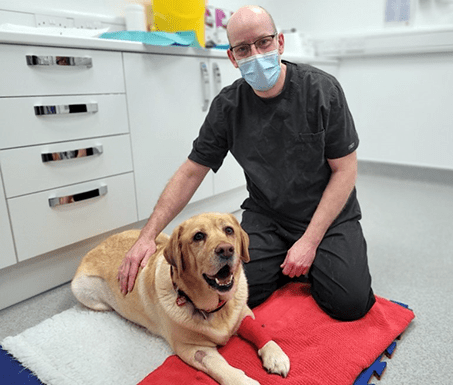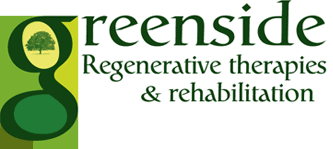What is a Stem Cell?
At Greenside Veterinary Practice, we focus on adult stem cells, which are one of two stem cell groups, the other being embryonic. An adult stem cell is found in every tissue of the body including bone marrow, adipose tissue (fat) and skin and liver. Stem cells are self-replicating and regenerative, with the ability to differentiate into other types of tissues. They encourage surrounding cells to heal damaged tissues. Stem cell veterinary practice uses this science to treat injuries and conditions long-term and potentially completely heal injured tendons and ligaments so that pets can return to being fully active.
How Stem Cell Veterinary Therapy Works
The process of stem cell therapy involves taking a sample from the patient which could be a fat or bone marrow extraction. This is then taken to the lab for a couple of weeks where it is cultured until ideal and to isolate the stem cells. It’s then readministered back to the patient at the point of injury with an injection. They will be injected in a concentrated form so that they perform a variety of tasks like differentiating into surrounding tissue types. It can form new cartilage, activate other stem cells in the vicinity and recruit other cell types to accelerate healing with growth. Stem cell veterinary therapy will also reduce inflammation and stimulate blood flow while protecting cells from dying. Stem cells will create a barrier for healing tissues but reduce or eliminate scar tissue.

What Stem Cell Therapy Treats
In veterinary medicine, stem cell therapy is used to treat a great number of diseases, conditions and injuries. See below:
- Degenerative Diseases
- Tendon injuries or tendinopathies
- Ligament Injuries
- Hip and elbow dysplasia
- Osteoarthritis
- Certain spinal conditions such as spondylosis, Lumbosacral disease and intervertebral disc disease.
- Fracture Repair
- Osteochondral Defects
- Organ dysfunction or failure e.g., Renal failure and Liver disease
- Auto-immune disease
Injuries to the ligaments and tendons are common in dogs and can take a long time to naturally heal due to poor blood supply. Stem cell veterinary therapy will regenerate and encourage faster healing but eliminate the growth of scar tissue. Scar tissue can decrease strength and flexibility in the affected area.
Below are examples of common tendon and ligament injuries that are treated with stem cell therapy:
- Supraspinatus tendon
- Biceps tendon
- Iliopsoas tendon
- Achilles tendon
- Carpal, tarsal and stifle collateral ligament
- Cranial cruciate ligament (partial tear)
Treating Arthritis
Dogs and cats commonly experience osteoarthritis or hip and elbow dysplasia which results in pain and wanting to be less active. These conditions can be managed with medication and adjustment of diet to manage weight. Stem cells have the potential to reduce inflammation and form new cartilage around the joints though. As a long-term solution for treating arthritis, stem cell veterinary therapy can manage the pain and potentially reverse or stop the degeneration of joints no matter the stage of the disease.
Alternatively, hydrotherapy and physiotherapy can maintain muscle strength and fitness in dogs and cats but can fail to provide long-term effectiveness and won’t solve the cause.
Neurological Conditions
Spinal conditions like lumbosacral disease, intervertebral disc disease and spondylosis cause chronic pain. Depending on the severity of the condition, this pain can be managed surgically, medicinally or with physiotherapy and laser therapy. Our success rate at Greenside is high for cases treated with stem cell therapy. There are many cases of additional conditions that have been treated at our practice and reports for positive results proceeding treatment of spinal diseases.
Our Stem Cell Veterinary Practice
Adult mesenchymal stem cells are harvested from adipose tissue (fat) or bone marrow which can differentiate into cartilage, bone, tendons, and ligaments to repair and regenerate. This method is the most common approach to treatment at Greenside Stem Cell Veterinary Practice as it’s the easiest to harvest and its ability to adapt culturally and store cells for future use.
With the fat that’s extracted for cells, a small blood sample is taken to provide a serum that the cells can be injected back into the affected site. This should reduce the chance of rejection and reaction.
For more detailed information on our stem cell methods including extraction and injection, read here or get in touch with our team for a reassuring discussion about your pet.
In order to support client's as well as their pets, we have takentime to assess what your pet's stem cell journey would also look like for their owners. Read what a stypically stem cell journey looks like here.
Greenside Stem Cell Veterinary
At Greenside we have a variety of regenerative treatments that work for many conditions and pets. We understand that your pet’s quality of life is important and making them comfortable and happy is at the front of everything we do. For our other therapies and treatments see here.
Contact Us
If your pet has been struggling with chronic pain, has had a recent surgery, or has a disease making them less active, speak to our professionals today. We are more than happy to advise you on the best method of treatment(s) for your pet and support them in their healing. We aim to restore happiness and a pain-free lifestyle to your dogs and cats, seek a referral from your local vet today. Alternatively, enquire via our contact forms.
Email:


